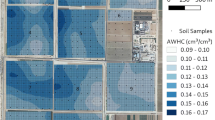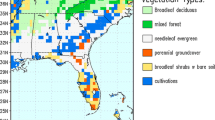Summary
There is an increasing demand from farmers for irrigation scheduling advice. Where rainfall and evapotranspiration vary little from year to year, advice on a fixed irrigation schedule based on mean climatic data can be given. However where significant year to year variability in weather occurs a more flexible approach using actual weather data to predict the current level of soil water and mean climatic data to forecast the future rate of depletion and hence irrigation date may be needed. A technique for deciding the most appropriate scheduling approach was tested by using a simple model of crop growth combined with a soil water balance model to simulate year to year variability in scheduling advice. This technique was applied to irrigated wheat using a set of climatic data from 1968 to 1978 for Griffith in the Murrumbidgee Irrigation Area of New South Wales, Australia. A typical sowing date in early June was used and simulated irrigations were scheduled at an allowable soil water depletion (ASWD) of 62 mm for maximum yield and 93 mm for 80% of maximum. The analysis predicted that weather variability between years would cause the number of irrigations to vary from 2 to 7 for ASWD=62 mm and 1 to 4 for ASWD=93 mm. The interval between irrigations varied from 12 to 30 days, for ASWD=62 mm and from 16 to 28 days, for ASWD=93 mm. The first irrigation occurred between 76 and 131 days from sowing for ASWD=62 mm and from 100 to 140 days from sowing for ASWD=93 mm. The date of the last irrigation was similarly variable. This high degree of variability in the times and frequency of irrigations indicated that in south-eastern Australia accurate irrigation scheduling advice can only be given by using a flexible model using both actual and mean climatic data. A fixed schedule based on mean climatic data would lead to an inefficient use of water caused by the mistiming of irrigations.
Similar content being viewed by others
References
Anon (1982) Winter Cereal Trials 1982. New South Wales Department of Agriculture. Coleambally, Griffith, Hillston, Hay and Leeton Agronomy Districts. Local Extension Publication, 21 pp
Anon (1983) Irrigated wheat management. New South Wales Department of Agriculture. Coleambally, Griffith, Hillston, Hay and Leeton Agronomy Districts. Local Extension Publication. D. West Government Printers 1983, 33 pp
Britton CM, Dodd JD (1976) Relationships of photosynthetically active radiation and shortwave irradiance. Agric Meteorol 17:1
Butler BE (1979) Soil survey of the horticultural soils in the Murrumbidgee Irrigation Area of NSW. CSIRO Bulletin No. 289 — revised edition of Bulletin No. 118 (1938) by Taylor JK, Hooper PD
Cooper JL (1980a) The effect of nitrogen fertiliser and irrigation frequency on a semi-dwarf wheat in south-east Australia. I. Growth and yield. Aust J Exp Agric Anim Hush 20:359
Cooper JL (1980b) The effect of nitrogen fertiliser and irrigation frequency on a semi-dwarf wheat in south-east Australia. II. Water Use. Aust J Exp Agric Anim Husb 20:365
Fereres E, Goldfein RE, Pruitt WO, Hendersen DW, Hogan RM (1981) The irrigation management program: A new approach to computer assisted irrigation scheduling. Proc Am Soc Agric Eng Irrig Sch Conf p 202
Idso SB, Jackson RD, Pinter PJ, Reginato RJ, Hatfield JL (1981) Normalising the stressdegree-day parameter for environmental variability. Agric Meteorol 24:45
Gallagher JN, Biscoe PV (1978) Radiation absorption, growth and yield of cereals. J Agric Sci Camb 91:47
Hatfield JL (1983) Evapotranspiration obtained from remote sensing methods. Adv Irrig 2:395
Jensen ME, Wright LJ, Pratt BI (1971) Estimating soil moisture depletion from climate, crop and soil data. Trans Am Soc Agric Eng 14:954
Mason WK, Meyer WS, Smith RCG, Barrs HD (1983) Water balance of three irrigated crops on fine-textured soils of the Riverina Plain. Aust J Agric Res 34:13
Meyer WS, Green GC (1981) Field test of an irrigation scheduling computer model. Water S Afr 7:43
Mood AM, Graybill FA (1963) Introduction to the theory of statistics. 2nd Ed, McGraw-Hill, Tokyo
Penman HL (1963) Vegetation and hydrology, Tech. Comm. 53, Commonwealth Bureau of Soils, Harpenden, Herts., England, 1963, p 124
Ritchie JT (1972) Model for predicting evaporation from a row crop with incomplete cover. Water Resour Res 8:1204
Smith RCG, Mason WK, Meyer WS, Barrs HD (1983) Irrigation in Australia: Development and prospects. Adv Irrig 2:99
Stegman EC (1983) Irrigation scheduling: applied timing criteria. Adv Irrig 2:1
Steiner JL, Smith RCG, Meyer WS, Adeney JA (1985) Water use, foliage temperature and yield of irrigated wheat in south eastern Australia. Aust J Agric Res 36:1
Stern WR (1965) Evapotranspiration of safflower at three densities of sowing. Aust J Agric Res 16:961
Watson WD, Reynolds RG, Collins DJ, Hunter RD (1983) Water 2000: Consultants Report No. 5, Agricultural Water Demand and Issues Aust Govt Pub Service 1983, p 215
Author information
Authors and Affiliations
Rights and permissions
About this article
Cite this article
Smith, R.C.G., Steiner, J.L., Meyer, W.S. et al. Influence of season to season variability in weather on irrigation scheduling of wheat: A simulation study. Irrig Sci 6, 241–251 (1985). https://doi.org/10.1007/BF00262469
Received:
Issue Date:
DOI: https://doi.org/10.1007/BF00262469




